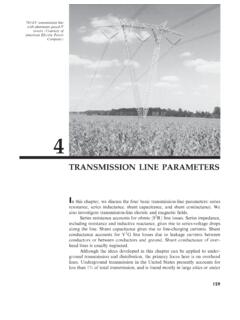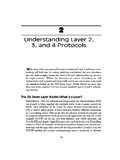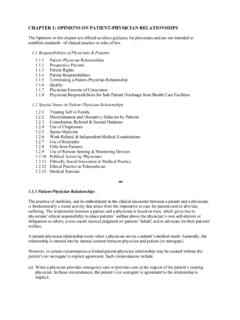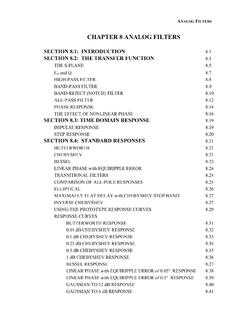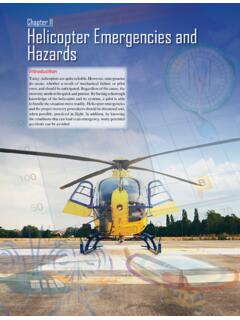Transcription of Chapter 2: Radio Wave Propagation Fundamentals
1 The Research University in the Helmholtz AssociationINSTITUTE OF Radio FREQUENCY ENGINEERING AND ELECTRONICSC hapter 2: Radio Wave Propagation Marwan Younis2 Institute of Radio Frequency Engineering and ElectronicsScope of the (Today s) LectureChapter 2: Radio Wave Propagation and FrequencySelective Radio ChannelAntennasfiltering, amplificationD Asource & channel decodingfiltering, amplificationdemodulationNoiseEffects during wireless transmission of signals: physical phenomenathat influence the Propagation of electromagnetic waves no statistical descriptionof those effects in terms of modulated signals3 Institute of Radio Frequency Engineering and ElectronicsPropagation PhenomenaChapter 2: Radio Wave Propagation Npath 1path ifreespace Propagation :-line of sight-no multipathdiffraction:-knife edge diffractionreflection:-plane wave reflection-Fresnel coefficientsscattering:-rough surface scattering-volume scatteringrefraction in thetroposphere:-not consideredIn general multipath Propagation leads to fading at the receiver site4 Institute of Radio Frequency Engineering and ElectronicsThe ReceivedSignalChapter 2: Radio Wave Propagation fadingsmall-scale fadingFadingis a deviationof the attenuationthat a signal experiences over certain Propagation may vary with time, positionand/or frequencyTimeFrequencySignal fadingClassification of fading: large-scalefading (gradual change in local average of signal level) small-scalefading (rapid variations due to random multipath signals)5 Institute of Radio Frequency Engineering and ElectronicsPropagation ModelsChapter 2: Radio Wave Propagation multipath conditions in urban areas (small-scale fading) Propagation models (PM) are being used to predict: averagesignal strength at a given distance from the transmitter variabilityof the signal strength in close spatial proximity to a particular locationPM can be divided into.
2 Large-scalemodels(mean signal strength for large transmitter receiver separation) small-scalemodels(rapid fluctuations of the received signal over very short travel distances)6 Institute of Radio Frequency Engineering and ElectronicsChapter 2: Radio Wave Propagation PropagationFreeSpace Propagation7 Institute of Radio Frequency Engineering and ElectronicsFree Space PropagationChapter 2: Radio Wave Propagation freespace equation:TxRxPtPrGtGrrno (influence of) groundAntenna effective area:Power density at Rx site:Received power:Assumptions: unobstructedline of sight (LOS) no multipathpropagation8 Institute of Radio Frequency Engineering and ElectronicsReceived Power and Path LossChapter 2: Radio Wave Propagation : polarization matched receiving antenna conjugate complex impedance matching of the receiverUsing:Path loss:Isotropic path loss (no antenna gains):ii9 Institute of Radio Frequency Engineering and ElectronicsChapter 2: Radio Wave Propagation of Field Vectors and Reference Planes10 Institute of Radio Frequency Engineering and ElectronicsPolarization of the EM WavesChapter 2: Radio Wave Propagation ellipticallypolarized EM wave can be decomposedinto a horizontaland a verticalcomponent.
3 LinearCircularElliptical11 Institute of Radio Frequency Engineering and ElectronicsPolarization: II, , V or H? Chapter 2: Radio Wave Propagation (E-field vector) with respect to the plane of incidence: parallel (II) perpendicular ( )TPolarization (E-field vector) with respect to the earth coordinates: vertical (V) horizontal (H)Plane of incidence:formed by thenormal vectorto the reflecting surfaceand Poynting vectorof the incidence waveEIIor EVEor EHT12 Institute of Radio Frequency Engineering and ElectronicsChapter 2: Radio Wave Propagation and TransmissionDielectric Boundary13 Institute of Radio Frequency Engineering and ElectronicsSnell sLaw of ReflectionChapter 2: Radio Wave Propagation r t surface large compared to the wave length smooth surface(otherwise scattering) three angles:-incidence-reflection-transmissio n / refraction*full derivation in Arthur Schuster: An Introduction to the Theory of Optics 12)sin()sin(nnti Relation between angles through Fermat s principle (principle of least time).
4 - the rays of light (EM-waves) traverse the path of stationary optical length This results in* Snell s laws:- ratio of the sines of the angles of incidence and refractionisequivalent to the opposite ratio of the indices of refraction - the incidence and reflectionangles are equal and they are in the same plane ri xrxrxn,, 14 Institute of Radio Frequency Engineering and ElectronicsWhich Part is Transmitted / Reflected? Chapter 2: Radio Wave Propagation procedure: Definition of the electric field strength of the incident wave Reflected and transmitted field strengths Faraday s law of induction Boundary conditions at the border between two dielectric media Decomposition of the incident waves on parallel and normal components15 Institute of Radio Frequency Engineering and ElectronicsFresnel Reflection & Transmission CoefficientsChapter 2: Radio Wave Propagation :parallelperpendicularFresnel coefficients are frequency dependentand in general complex16 Institute of Radio Frequency Engineering and ElectronicsBrewster s Angle (I) Chapter 2: Radio Wave Propagation , where no reflection occurs is Brewster s Angle: exists only for parallel (II / V) polarization calculation by comparing the reflection coefficient to zero calculation by using physical limitations 17 Institute of Radio Frequency Engineering and ElectronicsBrewster s Angle (II) Chapter 2.
5 Radio Wave Propagation (lessdense)Glass (dense)18 Institute of Radio Frequency Engineering and ElectronicsBrewster s Angle (III) Chapter 2: Radio Wave Propagation in degree19 Institute of Radio Frequency Engineering and ElectronicsBrewster s Angle (IV) Chapter 2: Radio Wave Propagation principle ofBrewster window: used for windows in optical or quasi optical systems window with normal incidence reflection loses at window window tilted at Brewster s angle no reflection loses at windowMicrowave gyrotronBrewster window20 Institute of Radio Frequency Engineering and ElectronicsTotal Internal Reflection(I) Chapter 2: Radio Wave Propagation does the total internal reflection appears? a ray must strike the medium s boundaryat an angle larger than the critical angle calculation by comparing thetransmission angle to 90 degree itcttiinnnntarcsinsinsin90 critical angle exists only for nt< niTotal reflection of red laser light in PMMAI ncreasing the incidence angle21 Institute of Radio Frequency Engineering and ElectronicsTotal Internal Reflection(II) Chapter 2: Radio Wave Propagation principle ofrain sensors: IR-beam projected on the glass-air interface at a specific angle total inner reflection in dry conditions partial transmission to the second medium if windshield is wet reduced receive power triggers the sensorRain sensor in the rear view mirror 22 Institute of Radio Frequency Engineering and ElectronicsVisualization Parallel Pol E-FieldChapter 2: Radio Wave Propagation Pol Air toGlassParallel Pol Glass to Air23 Institute of Radio Frequency Engineering and ElectronicsVisualizationPerpendicularPol E-FieldChapter 2.
6 Radio Wave Propagation Air toGlassPerpendicular Pol Glass to Air24 Institute of Radio Frequency Engineering and ElectronicsChapter 2: Radio Wave Propagation and(no)TransmissionPerfect Electric Conductor (PEC)25 Institute of Radio Frequency Engineering and ElectronicsOrthogonal PEC ReflectionChapter 2: Radio Wave Propagation waveEyHxSreflected waveEyRHxRSRyxzSREyHxEyRHxRBoundary conditions: 0tan,tan,tanriEEE 0,,rnorminormnormHHH26 Institute of Radio Frequency Engineering and ElectronicsPEC Reflection, Orthogonal PolarizationChapter 2: Radio Wave Propagation waveHxiHziHrEyiHiHzrHxrEyrEyHreflected waveaiyxzPEC reflectorai arPlane of incidencePEC reflection: RII= +1 R = -1 (to ensure Etan= 0)TSS27 Institute of Radio Frequency Engineering and ElectronicsPEC Reflection: ApplicationsChapter 2: Radio Wave Propagation calibration with metallic: dihedral trihedral (corner reflector)Reflection in the direction of incidence:Satellite radar calibrationRadar image with corner reflectorsBuoy with dihedral28 Institute of Radio Frequency Engineering and ElectronicsChapter 2: Radio Wave Propagation Model29 Institute of Radio Frequency Engineering and ElectronicsGeometryChapter 2: Radio Wave Propagation model is based on geometrical opticsand predicts large-scale fadingzTzRTRd1d2drjjground( )air ( = )30 Institute of Radio Frequency Engineering and ElectronicsAssumptionsChapter 2: Radio Wave Propagation in two-ray model: ground is PEC d >> zT,zRObservations: the received power PRoscillates like a sin2or cos2with distance the minimum value of PRis 0 the maximum value of PRis 4 PR,freespace(+ 6 dB)d31 Institute of Radio Frequency Engineering and ElectronicsLarge DistancesChapter 2: Radio Wave Propagation : d >> k0zTzR cos2x 1 sin2x x2 Observations: parallel pol: 20 dB / decade, perpendicular pol: 40 dB / decade perpendicular pol: independent on frequency perpendicular pol.
7 Antenna height gain(double zTor zR quadruplePR)32 Institute of Radio Frequency Engineering and ElectronicsBreakpointChapter 2: Radio Wave Propagation :The breakpointis the distance where the argument of thesin2 and cos2terms equals the breakpoint thereare no oscillations!33 Institute of Radio Frequency Engineering and ElectronicsPolarization DependenceChapter 2: Radio Wave Propagation polarizationparallel polarization1/d21/d21/d41/d26 dB6 dB6 dB6 dBindependent on frequencydependenton frequency34 Institute of Radio Frequency Engineering and Electronicsf = 900 MHzf = 4 GHzdbreakpointdbreakpointdistances of notches >> lFrequency DependenceChapter 2: Radio Wave Propagation of Radio Frequency Engineering and ElectronicsPath Loss PredictionChapter 2: Radio Wave Propagation (perpendicular) polarizationvertical (parallel) polarization80dB130dBpath loss200m0m50m0m2000mrange coordinate r(distance from transmitter) height z(above ground)80dB130dB200m0m50mheight z(above ground)0m2000mpath lossrange coordinate r (distance from transmitter) 36 Institute of Radio Frequency Engineering and ElectronicsChapter 2: Radio Wave Propagation on Absorbing Half-Plates37 Institute of Radio Frequency Engineering and ElectronicsKnife Edge Diffraction: GeometryChapter 2.
8 Radio Wave Propagation obstacle: semi-infinite, infinitely thin, absorbing plate calculate behavior behind the plate: Huygens principle wave Propagation behind the plate: sum of secondary wavesydTdRH>0z= Hxtransmittersecondaryspherical wavesreceiverrTrRz38 Institute of Radio Frequency Engineering and ElectronicsKnife Edge Diffraction: ModelChapter 2: Radio Wave Propagation )(21)(2121 SCEEH RTddH112l Field-strength relative to free space (no obstacle):Fresnel IntegralsAssumptions in knifeedge model: cylindrical waves (2D problem) Txand Rxat same height |H| << dT,dR39 Institute of Radio Frequency Engineering and ElectronicsKnife Edge Diffraction: ElectricField (I) Chapter 2: Radio Wave Propagation regionshadow region-6 dB RTddH112l 40 Institute of Radio Frequency Engineering and ElectronicsKnife Edge Diffraction: ElectricField (II) Chapter 2: Radio Wave Propagation regionshadow region-6 dBdB HEE0 if41 Institute of Radio Frequency Engineering and ElectronicsChapter 2: Radio Wave Propagation field strength normalizedto free space level isotropic Txantenna semi-infinite, absorbing plate f = 1 GHz, 3 GHz, 10 GHzdiffraction loss increases withfrequencyf 1 forKnifeEdge Diffraction: FrequencyDependence(I)42 Institute of Radio Frequency Engineering and ElectronicsChapter 2: Radio Wave Propagation Diffraction: FrequencyDependence(II)SINGLE KNIFE EDGE DIFFRACTION,FREQUENCY DEPENDENCE transmitter height = obstacle heightdistance transmitter to knife edge = 1000mdistance knife edge to receiver = 100m-6 dBf shadow / lit region43 Institute of Radio Frequency Engineering and ElectronicsFresnel EllipsoidsChapter 2.
9 Radio Wave Propagation Fresnel ellipsoidNth Fresnel ellipsoidNthFresnel zoneis bounded by an ellipsoid, where the Tx-Rx-path is N half wavelengths longerthan the direct Tx-Rx-path dT+ dRbetween Txand Rx2l NdddRTFNR adiusof NthFresnel ellipsoidTxRx44 Institute of Radio Frequency Engineering and ElectronicsWhen to Neglect the Knife Edge Diffraction? Chapter 2: Radio Wave Propagation Fresnel radius RFNwith diffraction parameter :If the knifeedge does not extend into 1stFresnel zone, then the error compared to free space Propagation is less than dB:2-1If the knifeedge does not extend into the 1stFresnel zone,then knifeedge diffraction can be neglected45 Institute of Radio Frequency Engineering and ElectronicsFresnel Ellipsoids: ExampleChapter 2: Radio Wave Propagation +dR+l0/246 Institute of Radio Frequency Engineering and ElectronicsChapter 2: Radio Wave Propagation of Incident Energy on Rough Surfaces47 Institute of Radio Frequency Engineering and ElectronicsDifferent Typesof ScatteringChapter 2: Radio Wave Propagation scatteringdistributed scatteringSimple targets(plate, sphere, cylinder, etc.)
10 Rough surfacescatteringvolume scattering48 Institute of Radio Frequency Engineering and ElectronicsFrom Specular Reflection to Incoherent ScatteringChapter 2: Radio Wave Propagation reflectioncoherent scatteringdiffuse scatteringsh iL ssh: RMS heightL: correlation lengthRoughness paremeter:Roughness criteria: sh l08cos iRayleigh: sh l032cos iFraunhofer:49 Institute of Radio Frequency Engineering and ElectronicsChapter 2: Radio Wave Propagation PropagationCombination of all Wave Propagation Effects50 Institute of Radio Frequency Engineering and ElectronicsPropagation PhenomenaChapter 2: Radio Wave Propagation Npath 1path ifreespace Propagation :-line of sight-no multipathdiffraction:-knife edge diffractionreflection:-plane wave reflection-Fresnel coefficientsscattering:-rough surface scattering-volume scatteringrefraction in thetroposphere:-not consideredIn general multipath Propagation leads to fading at the receiver site51 Institute of Radio Frequency Engineering and ElectronicsPath Loss Prediction over Natural TerrainChapter 2: Radio Wave Propagation Txheight = m vertical polarization f= 435 MHz f= 1900 MHzheightpath kmdistanceheightpath loss80 m0 m0 km70 dB150 dB80 m0 m0 km80 dB160 dB

